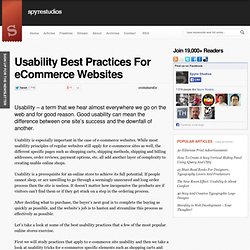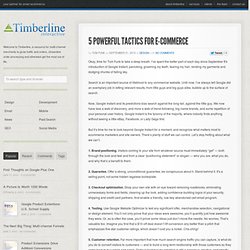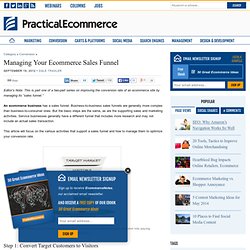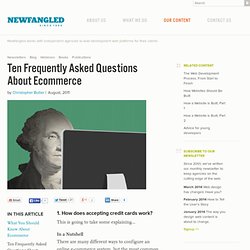

Usability Best Practices For eCommerce Websites. Usability – a term that we hear almost everywhere we go on the web and for good reason.

Good usability can mean the difference between one site’s success and the downfall of another. Usability is especially important in the case of e-commerce websites. While most usability principles of regular websites still apply for e-commerce sites as well, the different specific pages such as shopping carts, shipping methods, shipping and billing addresses, order reviews, payment options, etc. all add another layer of complexity to creating usable online shops. Usability is a prerequisite for an online store to achieve its full potential.
If people cannot shop, or are unwilling to go through a seemingly unsecured and long order process then the site is useless. After deciding what to purchase, the buyer’s next goal is to complete the buying as quickly as possible, and the website’s job is to hasten and streamline this process as effectively as possible. 5 Powerful Tactics for E-commerce. Okay, time for Tom Funk to take a deep breath.

I’ve spent the better part of each day since September 8′s introduction of Google Instant, panicking, gnashing my teeth, tearing my hair, rending my garments and dodging chunks of falling sky. Search is an important source of lifeblood to any commercial website. Until now, I’ve always felt Google did an exemplary job in letting relevant results, from little guys and big guys alike, bubble up to the surface of search. Now, Google Instant and its predictions bias search against the long-tail, against the little guy.
We now have less a web of discovery, and more a web of trend-following, big-name brands, and some repetition of your personal user history. But it’s time for me to look beyond Google Instant for a moment, and recognize what matters most to ecommerce marketers and site owners. Alltop - Top Ecommerce News. Ecommerce-marketing/ecommerce-shopping-cart-usability-21-best-practices/ #1 Subscribed Ecommerce Blog. Managing Your Ecommerce Sales Funnel. Editor’s Note: This is part one of a two-part series on improving the conversion rate of an ecommerce site by managing its “sales funnel.”

An ecommerce business has a sales funnel. Business-to-business sales funnels are generally more complex than business-to-consumer ones. But the basic steps are the same, as are the supporting sales and marketing activities. Service businesses generally have a different funnel that includes more research and may not include an actual sales transaction. This article will focus on the various activities that support a sales funnel and how to manage them to optimize your conversion rate. A sales funnel refers to the steps involved in converting a targeted market segment into paying customers. Step 1: Convert Target Customers to Visitors Invest the time to identify who your target customers are and how they likely seek out the products or services that you sell. Search engine optimization.
Step 2: Convert Visitors to Prospects.
Frequently Asked Questions About Ecommerce. 1.

How does accepting credit cards work? This is going to take some explaining… In a Nutshell There are many different ways to configure an online e-commerce system, but the most common way is to utilize a payment gateway system. The main thing you need to know is that, while you could easily create an online payment form that collects credit card information and relays it through your website and to you, that approach would not provide the level of security that you need to offer customers in order to safely conduct business with them on the web.
A payment gateway serves as an intermediary between your customers and your website, taking care of approving credit card transactions and capturing funds without interrupting the user experience unique to your website. The Play-By-Play A user fills out a payment form on your website and hits "Submit. " This entire process takes about two seconds. 2. 3. Definitely. 4. Probably not. The first has to do with your existing merchant account. 5. 6. A Comprehensive Guide to Planning an E-Commerce Website. It's expected that online retail spending will spike during the holiday season, but did you know that 3rd quarter online retail spending increased by 13% in 2011?

It's fitting, then, that as we begin the 3rd quarter of 2012, we recap on e-commerce. Last summer, I wrote an article on ten things you should definitely know about e-commerce, and in the spirit of summer sequels, here's part two. Have you ever stopped to consider what makes an e-commerce website successful? Is it good planning? Investment? Investment To do e-commerce well, you need to expect to make a significant investment — in time and money. As far as time is concerned, a general principle that applies to just about any web development project is that it will probably take more time than you plan for.
E-commerce is also expensive. Planning...for the Invisible Things If this first section doesn't contain the sort of info you thought you were getting when you clicked to read this article, fair enough.